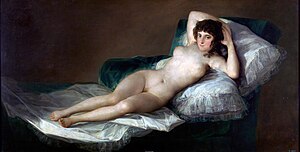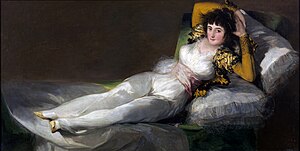| This article needs
additional citations for verification. Please help improve this article by adding reliable references. Unsourced material may be challenged and removed. (March 2008) |

Depictions of nudity refers to nudity in all the artistic disciplines including vernacular and historical depictions. Nudity in art has generally reflected — with some exceptions — social standards of aesthetics and morality of their time in painting, sculpture and more recently in photography.
Since prehistoric time, representations of the nude body has been a major theme in art.
Many cultures tolerate nudity in art more than actual nudity, with a different set of standards of what is acceptable. For example, even in a museum depicting nudity, nudity of a visitor is typically not accepted.
Sometimes live nudity is more acceptable if the model does not move; see Windmill Theatre. In other cultures, like Japan, where nudity carried no negative connotation, erotic shunga art tended to feature partially clothed participants.
Contents[hide] |
As social attitudes about artistic nudity have changed, this has sometimes led to conflict over art that no longer conforms to prevailing standards. For example, some members of the Roman Catholic Church once organized the so-called "fig-leaf campaign" to cover nudity in art, starting from the works of Renaissance artist Michelangelo, but the Church has since removed such fig leaves and restored the works.[citation needed] In contrast, it was conventional in ancient Greek art, from the time of the Archaic period onwards, to represent deities and divinized humans (or "heroes") in a state of heroic nudity in paintings and sculpture, and it remained so throughout the classical and Roman periods.
The nude has become an enduring genre of representational art, especially painting, sculpture and photography. It depicts people without clothes, usually with stylistic and staging conventions that distinguish the artistic elements (such as innocence, or similar theatrical/artistic elements) of being nude with the more provocative state of being naked. A nude figure is one, such as a goddess or a man in ancient Greece, for whom the lack of clothing is its usual condition, so that there is no sexual suggestiveness presumed. A naked figure is one, such as a contemporary prostitute or a businessman, who usually wears clothing, such that their lack of it in this scene implies sexual activity or suggestiveness (See also: nudity and sexuality). The latter were rare in European art from the Medieval period until the latter half of the 1800s; in the interim, a work featuring an unclothed woman would routinely identify her as "Venus" or another Greco-Roman goddess, to justify her nudity. There can be debate with regard to whether a figure in art is either nude or naked for example in some works of Francis Bacon.
Even though tastes changed significantly, semi-nude themes kept their attraction, even leading to copying of scenes from many centuries before.
Nudity in art, also publicly displayed, is rather common and more accepted than public nudity of real people. For example, a statue or painting representing a nude person may be displayed in public places where actual nudity is not allowed. However, there is also much art depicting a nude person with a piece of cloth or other object seemingly by chance covering the genitals. Some feel the selected focus of "Nude studies" lends itself to an impersonal, objectifying depiction of the human body; others say it can be as selectively depicted as a landscape.
A 1960s comedy sketch featuring English comedians Peter Cook and Dudley Moore admiring Cézanne's Les Grandes Baigneuses in the National Gallery humorously suggested that there must be hundreds of paintings that are not publicly displayed because the pieces of cloth did not fall in just the right places while the artist was painting them.
In modern media, images of partial and full nudity are used in advertising to draw additional attention. In the case of attractive models this attention is due to the visual pleasure the images provide; in other cases it is due to the relative rarity of images of nudity. The use of nudity in advertising tends to be carefully controlled to avoid the impression that the company whose product is being advertised is indecent or unrefined. There are also limits on what advertising media such as magazines allow. The success of sexually provocative advertising is claimed in the truism "sex sells". However, responses to nudity in American advertisements have been more mixed; nudity in the advertisements of Calvin Klein, Benetton, and Abercrombie & Fitch, to name three companies, have provoked much negative as well as positive response. (See also: Sex in advertising).
Of images of nudity (not necessarily pornographic), the most extreme form is full frontal nudity, referring to the fact that the actor or model is presented from the front and with the genitals exposed. Frequently images of nude people do not go that far and photos are deliberately composed, and films edited, such that in particular no genitalia are seen, as if the camera failed to see them by chance. This is sometimes called "implied nudity" as opposed to "explicit nudity."
 |
 |
| Goya's La maja desnuda and La maja vestida. Goya painted La maja vestida after outrage in Spanish society over the previous Desnuda. Without a pretense to allegorical or mythological meaning, the painting was "the first totally profane life-size female nude in Western art".[1] He refused to paint clothes on her, and instead created a new painting. | |